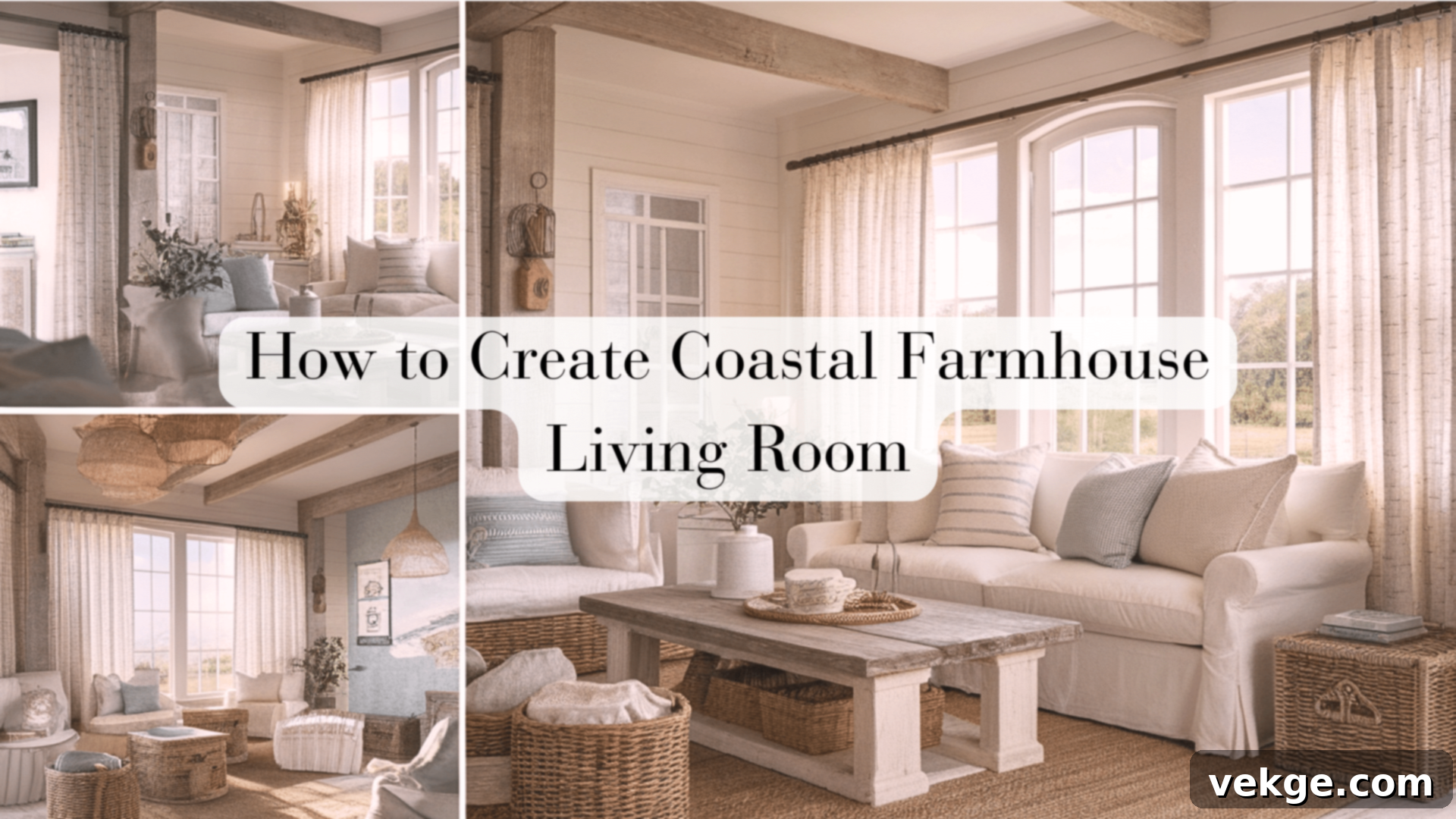Create Your Dream Coastal Farmhouse Living Room: The Ultimate Guide to Design & Decor
Imagine a living room that effortlessly combines the bright, breezy feel of a beach house with the warm, rustic charm of a countryside farmhouse. This unique blend, known as coastal farmhouse style, offers a serene and inviting atmosphere perfect for relaxation and gathering with loved ones.
Many homeowners are drawn to this captivating aesthetic but often struggle to perfectly marry the two distinct styles without making their space feel disjointed or overly decorated. It’s a common challenge to find that sweet spot between beachy lightness and farmhouse warmth.
As an interior designer who has guided numerous families in bringing this beautiful vision to life, I understand these challenges intimately. That’s why I’ve curated this comprehensive guide to walk you through every step, ensuring you create a fresh, cohesive, and deeply cozy living room that truly feels like home. You’ll discover:
- Expert advice on selecting the ideal furniture pieces that embody this unique style.
- Strategies for choosing the perfect color palettes and textural elements that tie the look together.
- Budget-friendly tips and clever hacks to achieve your desired coastal farmhouse aesthetic without breaking the bank.
Let’s embark on this design journey together and transform your living room into a beautiful, livable, and truly enchanting coastal farmhouse retreat.
Choosing the Perfect Color Palette for a Coastal Farmhouse Living Room

When it comes to colors in coastal farmhouse design, a fundamental truth I’ve learned through experience is this: less truly is more. The goal is to evoke a sense of calm and openness, much like the horizon where the land meets the sea. Starting with a foundation of clean, neutral shades sets the ideal mood and allows other elements to shine.
Begin with Light and Airy Base Colors
To create an immediate sense of spaciousness and brightness, opt for light base colors on your walls. Crisp white walls are a classic choice, instantly making any room feel more expansive and illuminated, reminiscent of fresh sea foam. Alternatively, soft beige or a gentle light gray can work beautifully, bringing in the subtle warmth of sun-bleached driftwood or the delicate shimmer of sand underfoot. These foundational hues are not just aesthetically pleasing; they create a versatile canvas that easily complements both coastal and farmhouse elements.
Infuse Gentle Ocean and Nature-Inspired Tones
Once your base is established, it’s time to introduce those signature water-inspired colors that define the coastal part of this style. These aren’t bold, vibrant shades, but rather muted, soothing tones that reflect the natural beauty of the seaside. Consider incorporating:
- Pale blue: Think of a clear, serene morning sky or the distant ocean horizon.
- Soft green: Evoke the delicate, aged beauty of sea glass or the subtle hints of marsh grass.
- Light aqua: This shade mirrors the inviting clarity of shallow, crystal-clear waters.
These colors can be introduced through throw pillows, subtle patterns in textiles, or decorative accents, ensuring they blend seamlessly rather than standing out harshly.
Keep Accent Colors Simple and Harmonious
To complete your palette, select just one or two additional accent colors. This might be a slightly deeper shade of blue for an anchor piece, a touch of sandy brown for grounding, or even a very subtle blush for a hint of warmth. The key is restraint. Too many bold or competing colors can disrupt the peaceful, cohesive feeling we’re aiming for, making the room feel busy and disconnected from its natural inspirations.
Here’s a helpful tip: Draw inspiration directly from nature. Observe the exquisite color combinations found in seashells—their subtle variations of white, cream, soft grays, and faint blues. Notice how seamlessly these shades blend together in nature; your room can achieve the same effortless harmony. Always avoid bright, neon, or overly saturated colors, as they tend to clash with the calm, quiet beach house ambiance you’re striving to create. Instead, envision your space as a tranquil coastal retreat, not a bustling boardwalk.
Incorporating Natural Materials: The Soul of Coastal Farmhouse Design
Natural materials are the very heart and soul of a coastal farmhouse room, imbuing it with authentic life, warmth, and texture. Through my design experience, I’ve found that the right combination of these elements can truly elevate a space, making it feel both grounded and airy. Let me share what consistently works best to achieve this coveted look.
Wood: The Unifying Element
Wood is indispensable. Its inherent beauty and history bring a sense of rustic authenticity. Look for furniture pieces that tell a story—perhaps an old console table with natural marks, a reclaimed wood coffee table with subtle imperfections, or a bookshelf crafted from weathered timber. These visible signs of age and character add immense depth and personality to your room, making it feel lived-in and loved. To create visual interest and prevent a monochromatic feel, try mixing light woods (like white oak or pine) with darker, richer tones (such as reclaimed barn wood or darker stained pieces). This contrast adds dimension without overwhelming the space. Consider a striking wooden mantelpiece or exposed ceiling beams for ultimate farmhouse charm.
Weave in Natural Textures and Fibers
To enhance the cozy and inviting aspect, integrate a variety of natural fibers. These elements add crucial texture and softness, appealing to both sight and touch:
- Wicker baskets: Perfect for stylishly storing blankets, magazines, or children’s toys, adding an organic, artisanal touch.
- Rattan chairs: Provide extra seating with a light, airy feel, bringing in a touch of tropical coastal charm.
- Jute or sisal rugs: Anchor your seating area, adding warmth to the floor and defining the space with their earthy texture.
- Linen and cotton fabrics: Use for upholstery, curtains, and throw pillows to introduce soft, breathable comfort.
These fibers are not just decorative; they offer practical durability and contribute significantly to the relaxed, unpretentious feel of the coastal farmhouse aesthetic.
Thoughtful Flooring Choices
Your flooring is the foundation of your entire design. It sets the stage for all other elements, so choose wisely. I highly recommend these options for a truly authentic look:
- Wide wooden planks: These are a hallmark of farmhouse style, offering a timeless, sturdy base that can be lightened with a white-wash or kept natural for a more rustic feel.
- Natural stone tiles: Ideal for entryways or areas prone to moisture, stone adds an earthy, robust element that connects to both coastal landscapes and traditional farmhouses.
- Sisal or seagrass rugs: Layer these over hardwood floors for added comfort, texture, and a direct nod to the natural, fibrous elements found by the sea. They are durable and bring an organic, grounding presence.
Remember to thoughtfully mix smooth and rough textures throughout your decor. Imagine a soft, plush cotton pillow resting on a rough-hewn wooden bench, or smooth, polished stones arranged in a textured, woven bowl. These subtle contrasts create visual intrigue and depth without making the room feel overly decorated or forced. The key is to keep things simple and intentional; a few thoughtfully chosen natural pieces will always have more impact than a cluttered space. Allow each natural material to truly shine and contribute its unique character to your coastal farmhouse haven.
Selecting Comfortable and Stylish Furniture
The furniture you choose will undeniably set the tone for your entire coastal farmhouse living room. As an interior designer, my philosophy is always that comfort comes first, but style is equally crucial. The art lies in finding pieces that perfectly marry both. Let’s explore how to select furniture that invites relaxation while maintaining that effortlessly chic aesthetic.
The Heart of the Room: Your Sofa
Begin with the most important piece: your sofa. Opt for a generous, plush sofa that beckons you to sink in and unwind. In coastal farmhouse design, white or cream slipcovers are not just aesthetically pleasing but incredibly practical. They can be easily removed and washed, making them ideal for busy households and maintaining a fresh, clean look. When choosing a sofa, I particularly love pieces with these features:
- Deep seats: Perfect for sprawling out, lounging, and truly relaxing.
- Soft, rounded arms: These add a gentle, inviting curve, contrasting with some of the sharper lines of traditional farmhouse pieces.
- Washable slipcovers: A non-negotiable for easy maintenance and a perpetually fresh appearance.
- Natural fabrics: Look for cotton, linen, or a durable blend, which are breathable, comfortable, and align with the natural material theme.
Infuse Character with Older, Found Pieces
To truly capture the farmhouse essence, mix in furniture pieces with history and character. These unique items add soul and a sense of timelessness to your space. An old wooden chest, for instance, can be repurposed as a stunning and functional coffee table. When hunting for these treasures, keep an eye out for:
- Painted dressers or cabinets: Especially those with charming, subtle peeling paint or a distressed finish.
- Chairs with weathered wood: Pieces that show the marks of time and use, adding authenticity.
- Tables with visible grain: Wood with a pronounced grain pattern adds natural texture and beauty.
These vintage or antique finds provide a beautiful contrast to newer, softer upholstery, creating a layered and intriguing look.
Craft Inviting and Functional Seating Groups
How you arrange your furniture profoundly impacts the room’s functionality and flow. Design your seating areas to encourage conversation and comfort. Position accent chairs at slight angles facing the sofa, creating an intimate conversation circle. Ensure that side tables and coffee tables are within easy reach for drinks, books, or decorative accents. Crucially, leave ample space between furniture pieces so people can move around the room freely and comfortably. A cramped room feels anything but relaxing, so prioritize an open, airy layout.
As you plan, consider how each piece of furniture will be used in your daily life. Keep the overall aesthetic light and balanced. Avoid the temptation to fill every corner with heavy, bulky items, which can make your room feel dense and cluttered. Instead, balance larger elements like your sofa with lighter, smaller pieces such as accent chairs, ottomans, and slender side tables. This thoughtful balance ensures your coastal farmhouse living room feels both abundant and effortlessly breezy.
Accessorizing with Coastal-Inspired Decor
Adding coastal touches is essential for this style, but the trick is to do it with restraint and intention, ensuring your room feels curated and authentic, not like a souvenir shop. Small, carefully chosen details can make a monumental difference in perfecting this unique aesthetic.
1. Natural Beach Finds: Authentic Touches
Bring the essence of the shore indoors, but do so selectively. Rather than displaying every shell you’ve ever collected, focus on a few special pieces that evoke a sense of calm and natural beauty:
- A single, striking piece of driftwood can serve as an organic centerpiece on a coffee table or a mantel.
- Gather three or four beautifully shaped shells in a simple glass bowl or jar, allowing their natural forms to be appreciated.
- Coil one or two old boat ropes artfully in a corner or by a fireplace for a subtle nautical nod.
- Consider a clear vase filled with fine beach sand and a few unique pebbles for a minimalist display.
These natural elements connect your interior space to the great outdoors without overdoing it.
2. Wall Art That Inspires Serenity
The art on your walls should contribute to the peaceful, airy atmosphere. Choose pieces that evoke tranquility and capture the spirit of the coast or countryside. I’ve found these options work particularly well:
- Classic black and white photographs of beaches, ocean waves, or coastal landscapes.
- Soft, impressionistic watercolor paintings depicting gentle waves, serene seascapes, or misty mornings by the water.
- Simple line drawings of marine life (like a single fish or a graceful seashell) or abstract forms inspired by the ocean.
- Botanical prints of marsh grasses or local flora framed simply.
Framing these pieces in light wood or white frames enhances their coastal appeal.
3. Practical and Pretty: Functional Decor
Look for items that not only add to the aesthetic but also serve a purpose, embodying the farmhouse principle of functionality. This approach keeps clutter at bay while adding style:
- White or natural metal lanterns: These provide soft, ambient lighting and are versatile decor pieces.
- Clear glass vases: Fill them with fresh beach grass, wildflowers, or simple green foliage.
- Sea grass or woven baskets: Ideal for discreetly hiding TV remotes, extra throws, or children’s toys, keeping your space tidy.
- Sturdy wooden trays: Perfect for organizing items on a coffee table or serving drinks.
Smart tip for arrangement: Group similar items in odd numbers – three vases or five candles often look more artful and balanced than an even number. Also, vary the heights of your decor. For example, place tall decorative grass in a vase next to a low, wide bowl of shells. This creates dynamic visual interest and prevents your space from feeling flat or cluttered. Always prioritize real, authentic items over artificial ones. Real shells, natural driftwood, and genuine artisanal pieces carry a story and a tactile quality that plastic or imitation items simply cannot replicate. Your room should feel honest, lived-in, and full of natural beauty. Don’t be afraid to change your accessories seasonally; in summer, lean more into obvious beach finds, and in winter, introduce cozier textures while retaining the underlying coastal spirit.
Enhancing the Ambiance with Thoughtful Lighting
Lighting is arguably one of the most powerful tools in interior design, capable of transforming a mundane room into a beautifully inviting space. In coastal farmhouse design, the goal is to create a delicate balance between bright, natural light and warm, cozy illumination. Let me share my tried-and-tested tips for perfecting this crucial element.
Embrace and Maximize Natural Light
Always start with your windows, as natural light is paramount. Dress them simply and elegantly to allow maximum light flow while maintaining privacy and softness. Light cotton or linen curtains are the ideal choice because they:
- Filter sunlight softly: Creating a gentle, diffused glow rather than harsh beams.
- Move gently in the breeze: Adding a subtle, dynamic element to the room.
- Maintain a degree of privacy: While still letting light permeate the space.
- Are easy to clean: A practical benefit for any well-used living room.
Consider roman blinds or woven wood shades for a textured look that can be pulled up to reveal the full window.
Select Natural Light Fixtures
Your overhead lighting should complement the natural, relaxed style. Opt for fixtures that feature organic materials and simple forms:
- Woven rattan pendants: These add texture and an immediate coastal vibe.
- Simple wooden chandeliers: Unfinished or white-washed wood evokes a rustic farmhouse feel.
- Industrial-style fixtures: With exposed bulbs or metal cages for a subtle nod to industrial farmhouse.
- Recessed lighting: For general, unobtrusive illumination.
Quick lighting tip: Install dimmers on all your overhead lights. This simple addition is incredibly transformative, allowing you to seamlessly adjust the room’s mood from bright, functional morning light to a soft, intimate evening glow. It gives you complete control over the ambiance.
Layer Warmth with Smaller, Task-Oriented Lights
To prevent your room from feeling sterile, layer in smaller, localized light sources around the space. This creates pockets of warmth and functionality:
- Table lamps: With linen or cotton shades, placed on side tables or console tables, offering soft, diffused light.
- Floor lamps: Positioned next to reading chairs or sofas, providing focused light for tasks or a cozy glow.
- Small accent lights: On shelves, inside display cabinets, or on side tables to highlight decor and add sparkle.
Strategically place lights at different heights. A mix of floor lamps, table lamps, and overhead fixtures creates soft shadows and a multi-dimensional feel, making the room feel incredibly inviting and welcoming. As a general rule, I recommend having at least three distinct light sources in any given room for optimal flexibility and ambiance. Remember to keep your light fixtures relatively simple in design. Plain white, natural wood, or woven materials allow the quality of the light itself to be the focal point, rather than the fixture being an overly ornate distraction. The aim is soft, diffused, and abundant light that enhances the natural beauty of your coastal farmhouse sanctuary.
Adding Comfort and Texture with Textiles
Textiles are the unsung heroes of a cozy living space. They add softness, warmth, and an inviting tactile quality that makes a room feel truly like home. In coastal farmhouse design, the right fabrics can effortlessly blend rustic comfort with breezy elegance. I’ll help you select and strategically place textiles that feel as good as they look.
Start from the Ground Up: Rugs
A well-chosen rug can anchor your seating area and instantly define the mood of the room. It should feel pleasant underfoot and contribute to the overall texture. Consider these options:
- Cotton rugs: Lightweight, often washable, and come in a variety of soft weaves and subtle patterns, perfect for easy-care comfort.
- Wool rugs: Offer exceptional softness, durability, and a luxurious feel, adding significant warmth underfoot.
- Natural fiber rugs (jute, sisal, seagrass): Provide earthy texture, are highly durable, and directly connect to the natural, coastal aesthetic.
- Layered rugs: For added depth, try layering a smaller, softer rug (like cotton or wool) over a larger natural fiber rug.
Opt for neutral colors or gentle patterns to maintain the serene coastal farmhouse palette.
Layer Your Sofas and Chairs for Maximum Comfort
Transform your seating into inviting havens of comfort by layering textiles. This creates a multi-dimensional look that feels incredibly plush and welcoming:
- Base cushions: Start with simple, durable cotton or linen cushions on your sofa and armchairs.
- Throw blankets: Drape a soft linen throw casually over one arm or corner of the sofa, or a chunky knit blanket for added warmth.
- Decorative pillows: Add two or three soft pillows in varying textures and subtle patterns (stripes, small checks, or gentle waves) to each seating area.
- Cozy blanket: Keep one or two ultra-soft blankets folded or draped nearby for those chilly evenings.
Here’s a useful tip for texture: Actively mix up your fabric textures. For example, pair a smooth cotton pillow with a chunky knit one, or a sleek linen throw with a fringed jute cushion. This creates visual and tactile interest without relying on bright colors or busy patterns, allowing the natural beauty of the fabrics to stand out.
Choose Simple and Subtle Patterns
When incorporating patterns into your textiles, think understated and organic. The goal is to add visual interest without disrupting the calm, cohesive flow of the room. Excellent choices include:
- Thin stripes: Reminiscent of beach grass or classic ticking stripes, they add a touch of tailored casualness.
- Small checks or ginghams: Evoke a traditional farmhouse feel without being overly rustic.
- Gentle waves or subtle ombré patterns: Mimic the natural movement of water or the fade of the horizon.
- Windowpane patterns: Simple and elegant, these can add a modern farmhouse touch.
Remember that textiles are not just about aesthetics; they are crucial for creating a warm, inviting, and comfortable atmosphere. By carefully selecting and layering fabrics, you can infuse your coastal farmhouse living room with a softness and depth that makes everyone feel right at home.
Incorporating Outdoor Elements Indoors
Bringing the vitality of nature inside is a cornerstone of both coastal and farmhouse styles. Plants, fresh greenery, and natural art effortlessly infuse any room with life, energy, and a refreshing sense of calm. The key is to integrate these elements thoughtfully, ensuring your living room feels vibrant without turning into an overgrown garden.
Choose Easy-Care Indoor Plants
Select plants that thrive indoors and require minimal fuss, allowing you to enjoy their beauty without constant maintenance. A few well-placed plants are more impactful than a multitude of small, struggling ones:
- Snake plants (Sansevieria): Excellent for empty corners or next to furniture, known for their architectural form and resilience.
- Potted ferns (e.g., Boston fern, Kimberly Queen fern): Bring lush, organic texture to side tables, shelves, or hanging planters.
- Small succulents or cacti: Perfect for shelves, coffee tables, or windowsills, adding a touch of desert-coast vibe with minimal watering needs.
- Fiddle Leaf Fig or Monstera: For a larger statement plant if your space allows, adding a touch of tropical elegance.
I find that three or four strategically placed plants, varying in size and height, create a more natural and visually appealing flow than a crowded collection. Place taller plants on the floor, medium ones on stands, and smaller ones on shelves or tables to create depth.
Fresh Touches Beyond Potted Plants
You don’t always need elaborate floral arrangements. Simple, fresh clippings from your garden or local market can have a profound impact:
- Cut grass stems: In clear glass vases, offering a minimalist yet impactful natural element.
- Small branches or twigs: Arranged in tall, slender containers for an architectural, rustic feel.
- Beach flowers or wildflowers: Displayed in simple white pitchers or mason jars for a touch of unpretentious charm.
- Eucalyptus branches: Their silvery-green leaves and fresh scent add a spa-like tranquility.
A simple plant care tip: Place your plants where they will naturally receive the appropriate amount of light for their species. Happy, thriving plants radiate positive energy and significantly enhance the ambiance of a room.
Natural Art and Textures
Extend the feeling of nature beyond living plants by incorporating natural elements into your art and decor:
- Simple botanical prints: Featuring leaves, ferns, or coastal flora on white backgrounds, framed in natural wood.
- Pressed seaweed or dried flowers: Arranged artfully in plain frames for a unique, organic wall accent.
- Woven grass wall hangings or macrame: Adding texture and a handcrafted feel to your walls.
- Ceramic or terracotta planters: Choose natural, unglazed finishes for your plant containers.
Mix your living plants with other natural, inanimate objects. For instance, position a potted fern next to a collection of smooth river stones in a wooden bowl, or place a small succulent on a stack of antique books. These intentional groupings create charming vignettes that draw the eye and reinforce the natural aesthetic. Always keep the look clean and fresh. Regularly dust your plant leaves, remove any yellowing or dead foliage, and change water in vases frequently. Nature is at its most beautiful when it is well-cared for, reflecting a serene and well-maintained living space.
Adding Personal Touches to Your Decor
Your living room should be more than just a beautifully designed space; it should be a reflection of who you are and the stories you cherish. Incorporating personal touches is vital for making your coastal farmhouse living room truly unique and inviting, all while maintaining its calm and cohesive feel.
Showcase What You Love and What Matters
Thoughtfully display items that hold special meaning to you, allowing them to add character and warmth to your decor:
- Family treasures: Heirloom pieces or special collectibles can be safely displayed in simple glass cases or on open shelves.
- Special finds from beach walks: That uniquely shaped seashell, a piece of sea glass, or a smooth pebble can be given pride of place.
- Items passed down from relatives: An antique vase, a vintage photograph, or a handmade quilt can instantly add history and sentiment.
- Childhood beach photos: Or beloved family pictures, displayed in simple white, natural wood, or distressed frames.
- Travel souvenirs: Small, natural-inspired mementos from trips can evoke cherished memories.
These pieces should be chosen for their emotional value, not just their aesthetic.
Make It Your Own with Simple DIY Projects
Infuse your personality with easy and enjoyable DIY projects that complement the coastal farmhouse style:
- Refresh old picture frames: A coat of white, light gray, or distressed paint can transform dated frames to match your new aesthetic.
- Create custom decor jars: Fill clear glass jars or antique bottles with beach sand, small shells, dried starfish, or even layers of colorful pebbles.
- Craft simple rope knots: Use nautical-grade rope to create decorative knots for wall art, curtain tie-backs, or even as embellishments on jars.
- Personalized signs: Paint a simple wooden sign with a favorite family quote or a coastal-themed word.
Personal touch tip: Place your most treasured personal items in prominent spots where you can see and appreciate them daily. A beloved photograph on a side table or a cherished heirloom on a coffee table brings more joy and personal connection than something hidden away on a high shelf.
Curate Photo Collections Thoughtfully
Family photos are a cornerstone of a cozy, lived-in home. Instead of scattering them randomly, create curated collections that tell a story:
- Group frames on a shelf: Arrange three to five frames of varying sizes but cohesive styles (e.g., all white or natural wood) on a single shelf.
- A simple gallery wall: Create a small, organized gallery wall using white or light-colored frames, mixing photos with subtle coastal art prints.
- Dominant photo with supporting pieces: Feature one large family photo prominently, flanked by two smaller, complementary images or a piece of beach-inspired art.
It’s important to keep your displayed items tidy and well-organized. While personal touches are essential, too many items scattered haphazardly can make a room feel cluttered rather than cozy. Select your favorite pieces and give them space to breathe and truly shine.
Remember to mix old and new elements for a truly authentic feel. Pair a new, fresh plant with an antique shell collection, or place a modern family photo next to a vintage wooden box. These thoughtful combinations make your room feel real, lived-in, and continuously evolving. Finally, always leave some empty space. Not every shelf or surface needs to be filled. Negative space allows your personal touches to stand out more effectively and contributes to the overall calm, uncluttered feel of your coastal farmhouse living room.
Coastal Farmhouse Living Room Ideas for Every Style
The beauty of coastal farmhouse design lies in its versatility. While it has core elements, it can be adapted to various personal tastes, from minimalist to bohemian. Let me guide you through different interpretations of this charming style, explaining why each one resonates and how you can achieve it in your own home. I’ve seen these styles successfully implemented in real homes, proving their adaptability and appeal.
1. Classic Coastal Farmhouse
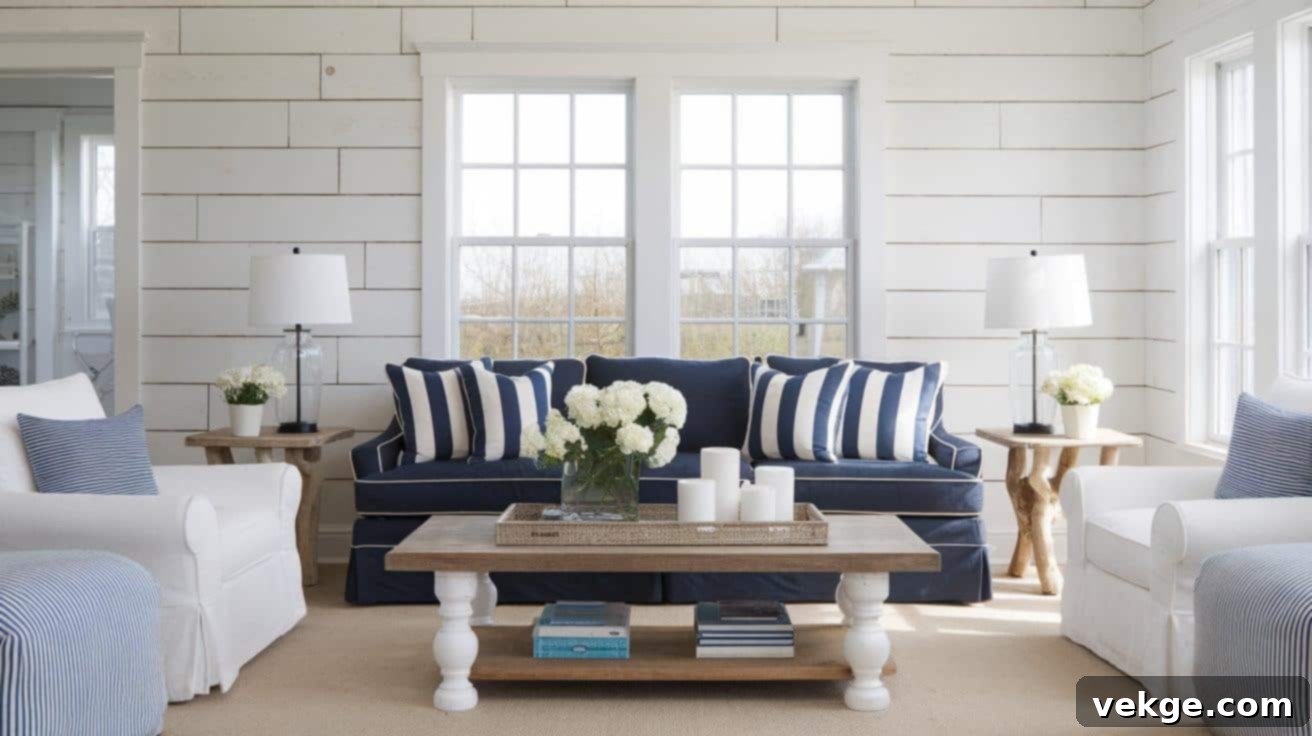
This is the quintessential blend, prioritizing comfort, natural elements, and a serene atmosphere. It’s clean, timeless, and effortlessly inviting. Key elements include:
- Foundation: White shiplap walls or light-colored paint paired with wide wooden plank flooring.
- Seating: A comfortable, oversized sofa in white, cream, or a soft navy blue slipcover.
- Furniture: Rustic wooden coffee tables and side tables, perhaps with distressed white legs.
- Textiles: Blue and white striped pillows, solid linen throws, and a natural fiber rug.
- Lighting: Simple glass lamps or a natural woven pendant light.
- Decor: A few large pieces of driftwood, glass vases, and simple framed coastal art.
2. Modern Minimalist Coastal Farmhouse
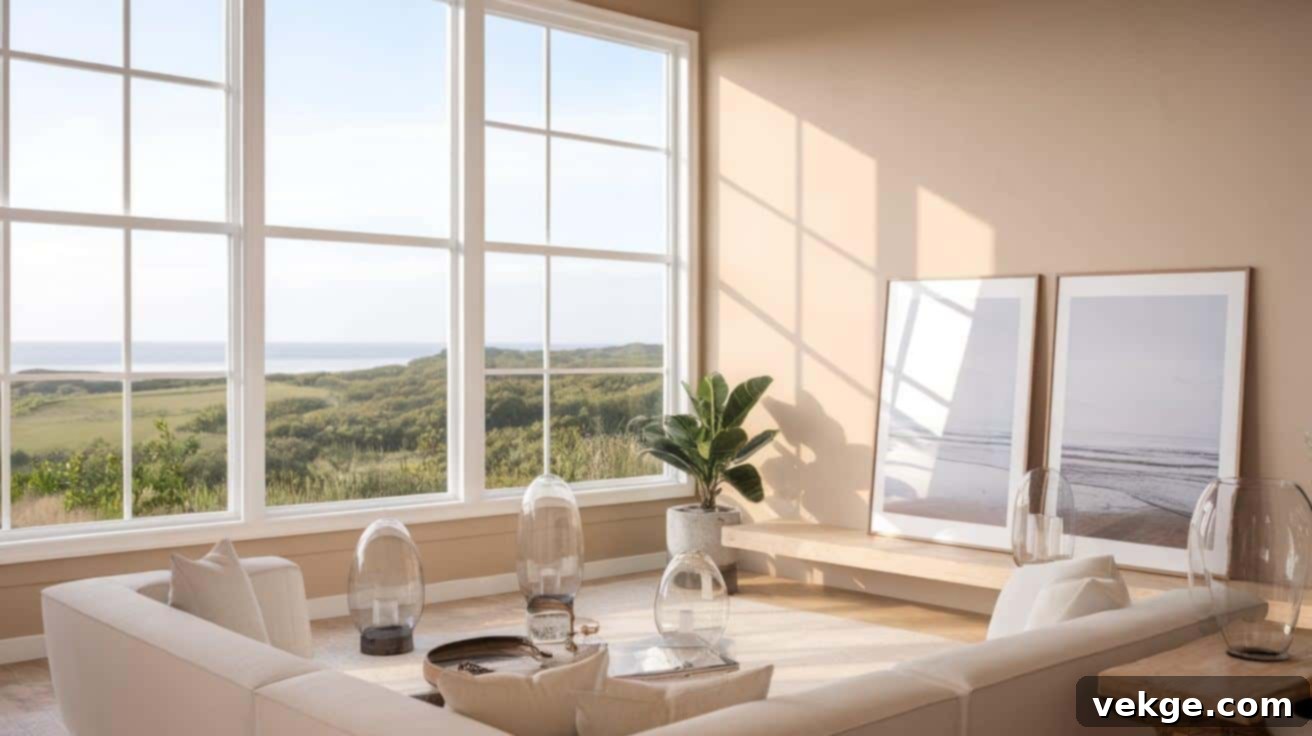
For those who love clean lines and uncluttered spaces, this style merges minimalist aesthetics with subtle coastal and farmhouse touches. It’s about simplicity and functionality without sacrificing warmth. I suggest:
- Colors: Extremely soft, muted color palette – think crisp whites, light grays, and very pale blues.
- Furniture: A low-profile, sleek white sofa; minimalist wooden shelves; and streamlined tables with clean lines.
- Decor: Clear glass vases, one or two abstract beach photos in thin, unobtrusive frames, and sculptural natural elements like a single large shell.
- Materials: Smooth finishes, light-toned woods, and minimal patterns.
3. Bohemian Beach House Farmhouse
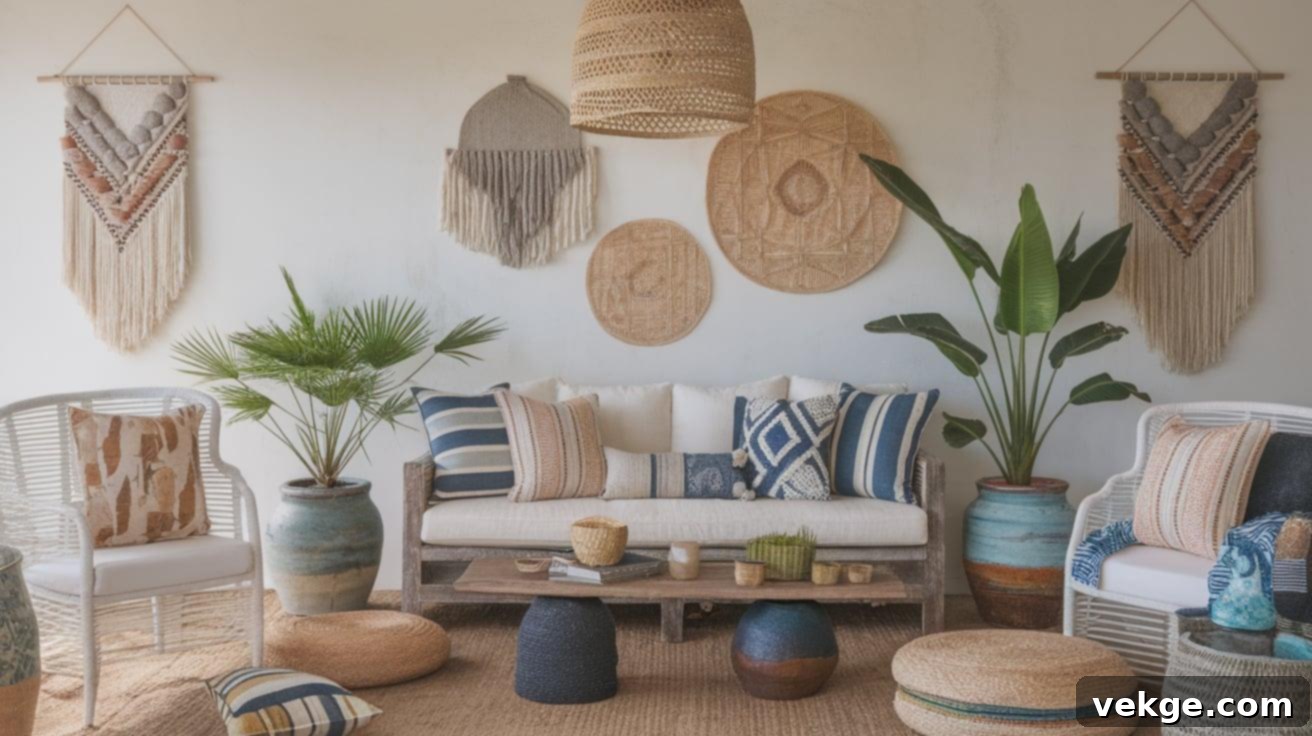
This style invites you to play with more textures, patterns, and global influences, all while maintaining a relaxed, free-spirited coastal vibe. It’s eclectic, comfortable, and full of personality.
- Colors: A broader palette incorporating soft terra cottas, muted greens, and deeper blues alongside neutrals.
- Seating: Layered soft cushions in different patterns (ikat, tribal, subtle floral) on a base sofa, perhaps a rattan chair with plush seating.
- Decor: Woven wall hangings (macrame), plants in handmade ceramic pots, floor pillows, and artisanal decor from around the world.
- Furniture: Mix old and new pieces freely, often featuring distressed wood, carved details, and low-slung profiles.
4. Rustic Seaside Retreat
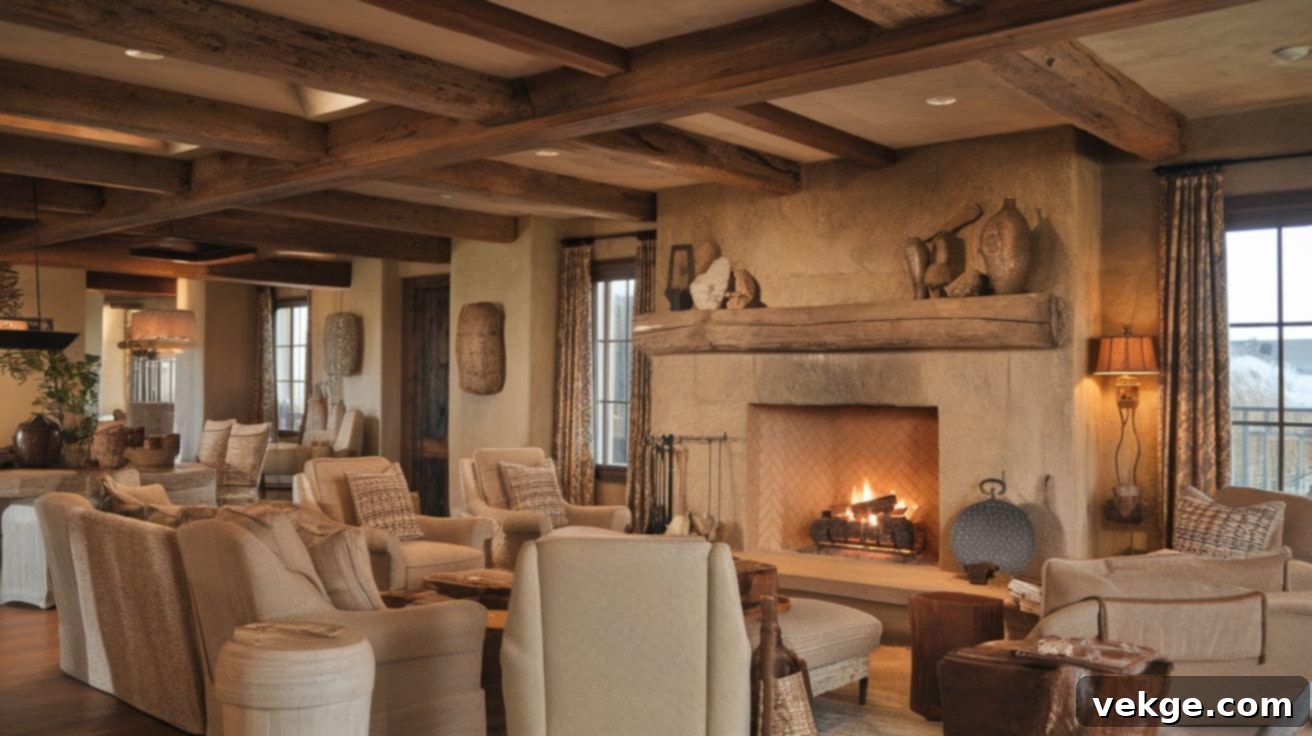
This interpretation leans heavily into the farmhouse’s rustic roots, evoking the feel of a cozy, weather-beaten beach cabin or a charming coastal cottage. It prioritizes warmth, texture, and natural, robust materials.
- Materials: Abundant use of rough-hewn wood, natural stone around a fireplace, and exposed wooden ceiling beams.
- Seating: Big, sink-into-me comfy chairs and sofas in durable, textured fabrics like heavy linen or canvas.
- Colors: Earthier tones such as deep grays, charcoal, and deeper blues mixed with creams and beiges.
- Decor: Cast iron elements, vintage maritime tools, hurricane lamps, and thick, chunky knit throws.
5. Nautical-Inspired Nook
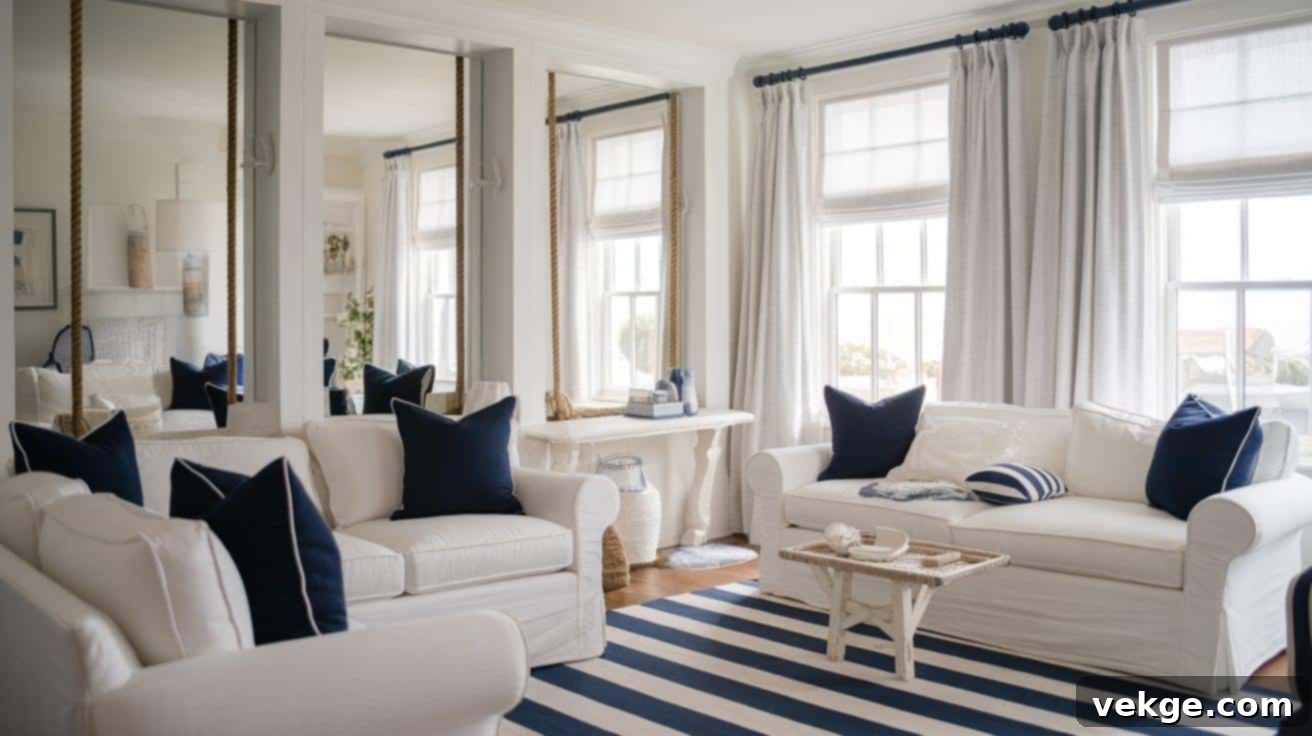
This style embraces classic nautical elements but integrates them with farmhouse warmth for a refined yet relaxed feel. It’s crisp, clean, and evokes classic seafaring charm.
- Colors: A strong emphasis on navy blue and crisp white, often with pops of red or brass.
- Furniture: White slipcovered sofas with navy throw pillows; dark wood accents.
- Decor: Rope-wrapped mirrors, framed maps or charts, model boats, and clear glass fishing floats.
- Textiles: White cotton curtains, striped rugs, and throws with subtle anchor or compass motifs.
6. Tropical Coastal Farmhouse
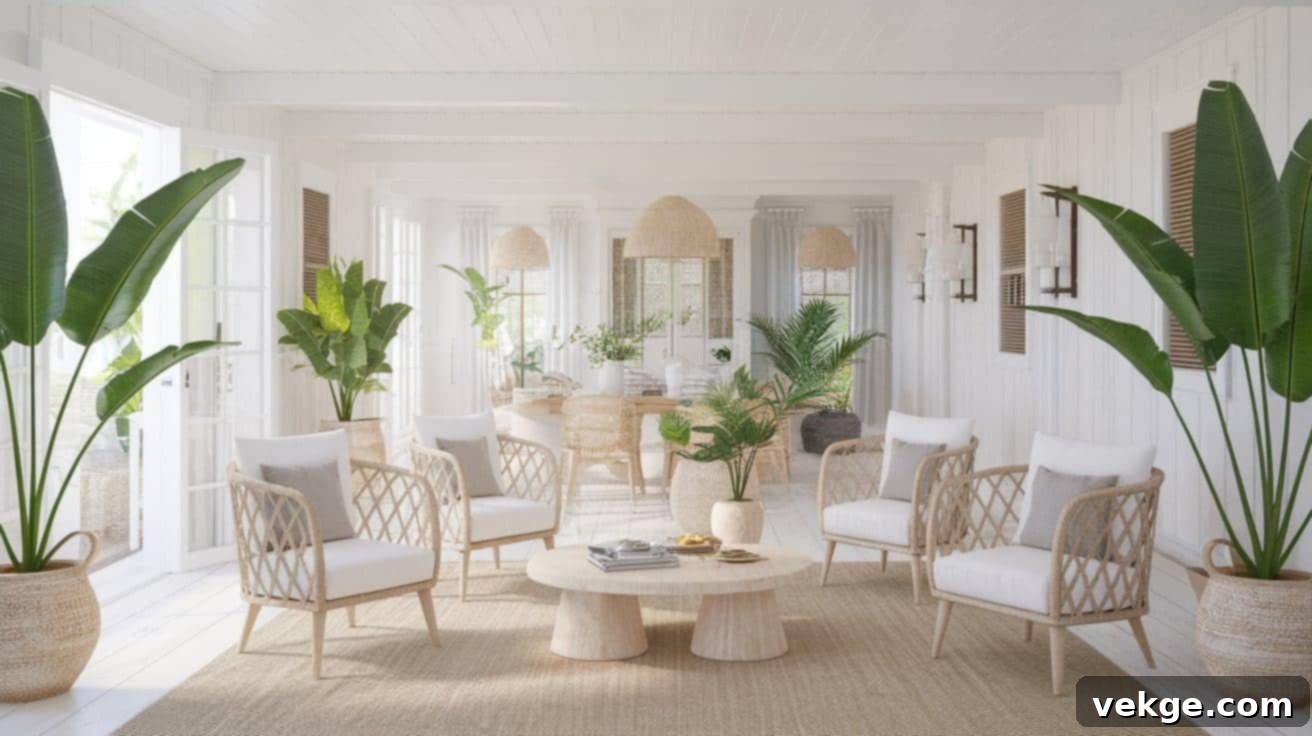
For a lighter, more exotic touch, this style infuses tropical influences into the coastal farmhouse aesthetic. It’s vibrant yet serene, with a focus on lush greenery and natural textures.
- Furniture: Light-toned rattan or wicker chairs with white cushions; bamboo accents; light wood tables.
- Plants: Abundant large leafy plants like monsteras, bird of paradise, or palm varieties.
- Colors: Incorporates soft greens, yellows, and muted coral alongside the classic coastal farmhouse palette.
- Decor: Shell-encrusted mirrors, driftwood elements, natural woven baskets, and botanical prints of tropical leaves.
7. Vintage Coastal Charm
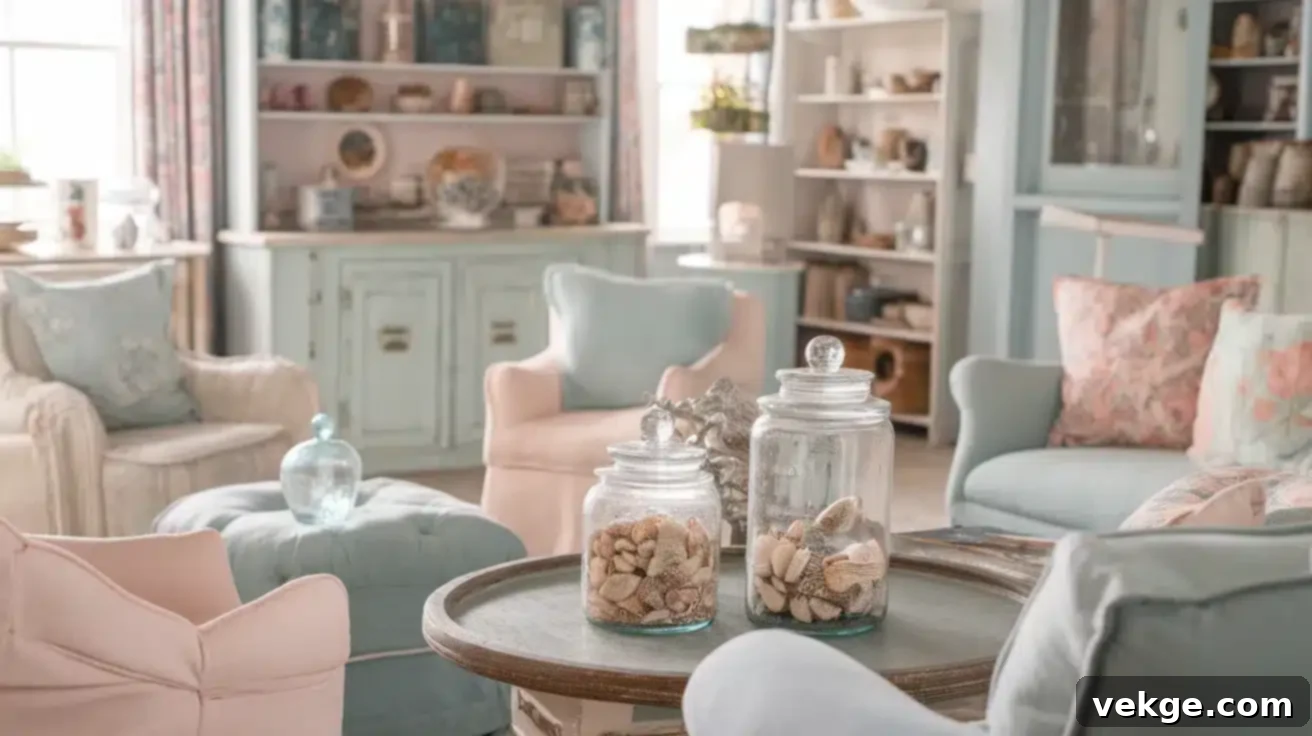
This style leans into a romantic, nostalgic feel, blending antique finds with soft, sun-faded coastal elements. It’s gentle, lived-in, and full of character.
- Furniture: Old painted furniture with distressed finishes, antique chests repurposed as tables, and charming vintage seating.
- Colors: Soft, muted blues, pale greens, dusty pinks, and creams, reminiscent of faded seaside postcards.
- Textiles: Delicate lace details, soft floral patterns, subtle stripes, and embroidered fabrics.
- Decor: Small shell collections in old apothecary jars, vintage glass bottles, antique nautical instruments, and delicate framed pressed botanicals.
Remember: When choosing your specific interpretation, commit to your style choice. Trying to incorporate too many distinct looks at once can lead to a confused aesthetic. A clear, focused direction will always result in a more cohesive, harmonious, and beautiful coastal farmhouse living room that truly speaks to your individual taste.
Conclusion: Creating Your Perfect Coastal Farmhouse Haven
Creating your dream coastal farmhouse living room doesn’t have to be an overwhelming task. By approaching the design with intention and following these expert guidelines, you can transform your space into a serene, beautiful, and deeply personal sanctuary. Remember to start with a foundation of light, airy colors and simple, comfortable furniture that invites relaxation.
Layer in the warmth and texture of natural materials like weathered wood, soft cotton, and woven fibers. Thoughtfully incorporate unique beach finds and cherished family items that tell your story, ensuring your decor feels authentic and lived-in. Don’t forget the transformative power of good lighting, balancing natural light with strategic ambient and task lighting.
Keep these key elements at the forefront of your design journey:
- Soft, comfortable seating: The heart of any living room, inviting relaxation and gathering.
- Layered lighting: A mix of overhead, task, and accent lights at different heights to create a warm ambiance.
- Personal, meaningful items: Curated decor that reflects your personality and cherished memories.
- Natural textures and materials: Wood, linen, jute, and plants to ground the space and add organic beauty.
The most wonderful aspect of this style is that it encourages a gradual evolution. You don’t need to complete everything at once. Begin with the larger foundational pieces like your sofa and rug. Then, slowly add smaller decorative items, textiles, and personal touches as you discover pieces you genuinely love. Each careful choice you make will contribute to a living room that grows more special, unique, and welcoming over time.
Ultimately, make this style your own. The most inviting and memorable rooms are those that not only embrace a beautiful aesthetic but also authentically tell your story, all while maintaining that peaceful, breezy, and deeply comforting coastal farmhouse feel.
Frequently Asked Questions About Coastal Farmhouse Living Rooms
How Much Should I Budget for a Coastal Farmhouse Living Room Makeover?
The budget for a coastal farmhouse living room makeover can vary significantly based on the extent of the changes and your choice of materials. A basic refresh, which typically includes new paint, a few key furniture pieces (like a sofa or accent chairs), and essential decor items, usually ranges from $2,000 to $3,000. This allows for impactful changes without major structural work. For a more comprehensive renovation, encompassing new flooring, premium-quality furniture, custom built-ins, and a full suite of accessories, you might expect to spend anywhere from $8,000 to $15,000 or more. Remember, starting with high-quality core pieces and gradually adding decor can help spread costs over time.
Can I Create A Coastal Farmhouse Look in A Small Apartment?
Absolutely! The coastal farmhouse style is wonderfully adaptable for smaller spaces. To achieve this look in a small apartment, focus on strategies that maximize space and light. Prioritize a light and bright color palette, using white, off-white, and pale neutrals on walls to make the room feel larger and more open. Opt for multi-purpose furniture, such as ottomans with storage or console tables that can double as desks. Choose fewer but more meaningful decor pieces to avoid clutter, allowing each item to make an impact. Incorporating mirrors strategically can also dramatically enhance the feeling of space and reflect natural light. Finally, ensure good lighting throughout the room to keep it feeling airy and expansive.
How Do I Maintain White Furniture in A Family-Friendly Coastal Farmhouse Living Room?
Maintaining white furniture in a busy, family-friendly environment is entirely achievable with the right choices and practices. The most effective solution is to choose furniture with removable and washable slipcovers made from durable cotton or linen. This allows you to easily clean spills and refresh the fabric. Consider investing in high-performance or indoor-outdoor fabrics, which are designed to be stain-resistant and easy to wipe clean, offering peace of mind. Keeping a reliable fabric protector spray (like Scotchgard) handy can also provide an extra layer of defense against accidental spills. Another practical tip is to consider white or off-white furniture that has a subtle texture or pattern, such as a herringbone weave or a faint stripe, as these can be more forgiving and help to subtly camouflage small marks between washes. Regular vacuuming and spot cleaning will also extend the life and cleanliness of your white pieces.
